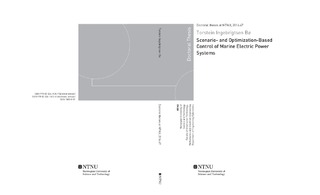| dc.description.abstract | Diesel electric propulsion has become the industry standard for e.g., oil and
gass vessels, cruise vessels, ferries, and vessels with dynamic positioning
(DP) systems. Diesel engines are paired with generators to produce electric
energy, which is used by electric motors for propulsion of the vessel, and also
by other consumers, such as hotel loads, drilling drives, cranes, and heave
compensators. This system is reliable and efficient due to the flexibility of
the electric grid. DP is often used as a motivating example in this thesis.
The thrusters of a vessel using DP is used to fix the position and heading of
the vessel. The power plant is operated with redundancy, as a single fault
should not lead to loss of position. However, this redundancy decreases the
efficiency of the power plant. This thesis presents new ideas and results on
how to increase the efficiency of a hybrid power plant with diesel generator
sets and batteries while maintaining the required safety level.
A model of a marine vessel is presented in Chapter 2. This model includes
the power plant, a hydrodynamic model, and control systems. The
power plant includes generator sets, batteries, switchboards, thrusters, and
hotel loads. Environmental loads are included in the hydrodynamic model,
such as first and second order wave loads, mean and gusting wind, and
ocean current, along with the hydrodynamic model of the vessel and the
thrusters. The included control systems are a power management system, a
DP-controller, thrust allocation, and low level controllers of producers and
consumers. Earlier marine vessel simulators mainly focused on the hydrodynamic
model or the power plant. However, the present model combines the
three models, to investigate the complex integration and interaction effects
between the models. These interaction effects are especially important when
investigating the DP performance after faults in the power plant. Chapter 2
presents the models needed for this integration. Three simulation cases are
presented, to shows that the simulator can capture the interaction effects.
A simulation-based dynamic consequence analysis is presented in Chapter 3. The tool uses the simulator from Chapter 2 to simulate several possible
worst case scenarios. This tool can be used by the operator to optimize
the electric power plant configuration, and to show that no single failure
lead to loss of position. The dynamic consequence analysis is necessary
when stand-by generators are considered, as the vessel may lose position
during the time from when the fault occurs until the plant fully recovers,
even if the vessel maintains its position after recover.
A scenario-based model predictive controller (MPC) is presented in
Chapter 4. This controller uses fault scenarios, internally, to constrain the
nominal trajectory, which is an alternative to conventional static safety constraints.
The control of generator set speed of a marine power plant is used
as a case study. Simulations show that fault scenarios can replace static
safety constraints by using this controller.
Chapter 5 presents a method to control peak-shaving. Peak-shaving by
batteries is used to cancel out power fluctuations, which cause variations
in the electric grid’s frequency. However, the batteries may get too hot
if power demand is too large. The proposed controller, based on a power
spectrum analysis and MPC, reduces the power fluctuations as much as
possible without letting the battery get too hot. Simulations using data
generated by the simulator in Chapter 2 showed that the controller can
achieve these objectives as long as the characteristics of the load does not
change too rapidly.
Use of the vessel itself as energy storage during DP operation is explored
in Chapter 6. A vessel oscillates about its mean position by reducing
the thruster power when the total power demand of the vessel is high and
increasing it during periods of low power consumption. An analytical formula
for motion amplitude given by power amplitude is calculated in this
chapter. The formula is compared with simulations, and the simulation results
agreed with the formula. It is also shown that the resulting deviations
in position from variations of several megawatts are no larger than typical
position deviations from the dynamics of ocean waves and wind.
The proposed models and controllers are demonstrated through simulations
using MATLAB/SIMULINK. The MPC-based controllers are implemented
in ACADO. | nb_NO |
